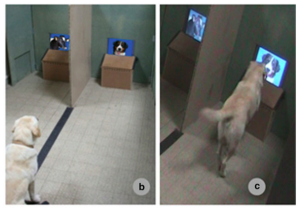Bumping again
Can your dog recognize you from a picture? | Smart Animal Training Systems...

 No levers!
No levers! The dogs simply chose a picture and walked to it and touched it with a nose
Study proves dogs recognize their owners' faces | MNN - Mother Nature Network
This article talks about the myriad issues surrounding studying animals, and includes the Hans the Clever Horse story
Quote:
Animal Cognition (Stanford Encyclopedia of Philosophy)
The method that Darwin, Romanes and their contemporaries first used to investigate these questions could be described as the anecdotal method. Stories about animal behavior were collected from a variety of people, including military officers, amateur naturalists, and layfolk, and were compiled and used as evidence for a particular cognitive capacity in that species. This approach was widely criticized. The “evidence” gathered was often a story told about an event witnessed by a single person, usually not a trained scientific observer. In addition, these stories were often acquired second- or third- hand, so there were worries that the reports had been embellished or otherwise altered along the way. These problems were recognized early on, and in response Romanes developed three principles for accepting anecdotes in order to avoid some of these problems:
Never accept an incident report as fact without considering the authority or respectability of the observer.
If the observer isn't known, and the incident report is sufficiently important, consider whether the observer may have reason or cause to make an inaccurate report.
Look for corroborations of the observation by examining similar or analogous observations made by other independent observers (Romanes 1970).
The third principle was the one he most relied on, writing “This principle I have found to be a great use in guiding my selection of instances, for where statements of fact which present nothing intrinsically improbable are found to be unconsciously confirmed by different observers, they have as good a right to be deemed trustworthy as statements which stand on the single authority of a known observer, and I have found the former to be at least as abundant as the latter” (Romanes 1970, ix).
Despite Romanes' attempts, the method remained problematic insofar as it didn't provide any statistical information about the frequency of such behaviors; selection bias would lead people to report only the interesting intelligent behaviors and ignore the frequency of behaviors that might serve as counterevidence. Thus, the anecdotal method as practiced by Darwin and Romanes lacks many of the virtues associated with good scientific methods.
|
Quote:
|
Today scientists continue to conduct experiments in laboratory settings, but they also attempt to mirror the richness of the animal's natural environment. For example, the research coming out of Kyoto University's Primate Research Institute (PRI) is based on a three-part research program (Matsuzawa et al. 2006). First, the physical, cognitive, and social development of chimpanzees is taken into account in the design of experiments, and subjects are raised by their mothers rather than by human caregivers or unrelated animals. In addition, lab work and fieldwork is synthesized; field observations are used to develop experiments, and experiments are conducted both in the field and in the laboratory. Finally, the method includes analysis of the physiological and biological features of the species that could be related to cognitive abilities.
|
Research is ongoing all over the world, so Lessans was missing a ton of information when he wrote about dog cognition
Duke University | Evolutionary Anthropology: Duke Canine Cognition Center